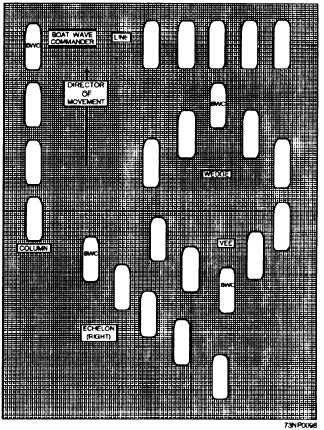completed. At the end of start and stop signals the light
is blinked several times. Night signals are repeated as
necessary. The formations used are illustrated in figure
12-17. Assault boat coxswains should know all of
these signals and formations. Those signals
concerning starting, stopping, breakdown, towing,
and so on, might also prove useful to any coxswain in
the event of an emergency.
The naval beach party is landed early in the
assault. When they reach the beach, they proceed with
their duties of marking channels and hazards to
navigation, establishing communications, improving
beaches, and so forth.
After a boat unloads on orders from the beach
party, it retracts past the surf line and proceeds to a
designated flank of the boat lane. Keeping clear of the
boat lane, it proceeds to seaward and reports to the
control vessel for further orders.
GENERAL UNLOADING PHASE
During the general unloading phase, loaded boats
do not maintain a formation on the trip to the beach,
although several of them may be required to move as
a unit. On the way to the beach they must stop for
orders at the PCS and the BGC's boat.
The type of cargo in a boat is indicated by the color
of special flags flown. Red denotes bulk cargo, which
needs manpower for unloading; yellow shows the load
is such that a prime mover is required; blue denotes
self-propelled cargo; and a red burgee shows the boat
is a bowser (fuel) boat. A green flag shows a boat
belongs to a floating dump, and a numeral flag may be
flown under it to indicate the type of cargo carried.
SUMMARY
In this chapter, you have learned the general
concept of an amphibious operation and the different
Figure 12-17.—Boat formations.
ships, boats, and landing craft involved. You have
learned about standard flags and markers, control
areas, and debarkations. You also have learned to
transmit grid position both by radio and visually and
the procedures for dispatching waves to the LOD
during daylight and nighttime. You have learned the
duties of the different personnel associated with an
amphibious landing. Although this chapter has a lot of
information to learn about amphibious landings, your
best source of information is NWP 22-3.
12-32


